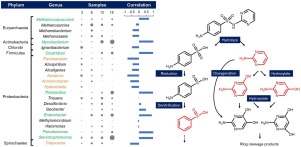Journal of Hazardous Materials ( IF 13.6 ) Pub Date : 2018-08-16 , DOI: 10.1016/j.jhazmat.2018.08.021 Lu Wang , Lexing You , Jiaming Zhang , Tao Yang , Wei Zhang , Zhongxiang Zhang , Pinxing Liu , Song Wu , Feng Zhao , Jun Ma

|
Sulfadiazine (SDZ) is a high priority sulfonamide antibiotic and was always detected in environmental samples. This study explored the removal of SDZ in microbial fuel cells (MFCs), in terms of MFC operation, degradation products, reaction mechanism, SDZ biotoxicity removal, and the correlation between microbial community and SDZ removal. SDZ would greatly impact the activity of reactor microbes, and longtime acclimation is required for the biodegradation of SDZ in MFCs. After acclimation, 10 mg/L of SDZ could be removed within 48 h. Liquid chromatographic-mass spectroscopic analysis showed that SDZ could be degraded into 2-aminopyrimidine, 2-amino-4-hydroxypyrimidine and benzenesulfinic acid. Compared with published SDZ biodegradation mechanism, we found that the sulfanilamide part (p-Anilinesulfonic acid) of SDZ would be degraded into benzenesulfinic acid in the system. The effects of background constituents on SDZ biodegradation were explored, and co-existed humic acid (HA) and fulvic acid (FA) could accelerate the removal of SDZ in MFCs. After analyzing the reactor microbial community and the removal of SDZ at different operation cycles, it was found that the relative abundance of Methanocorpusculum, Mycobacterium, Clostridium, Thiobacillus, Enterobacter, Pseudomonas, and Stenotrophomonas was highly correlated with the removal of SDZ throughout the experiment.
中文翻译:

微生物燃料电池中磺胺嘧啶的生物降解:反应机理,生物毒性去除及其与反应堆微生物的关系
磺胺嘧啶(SDZ)是一种高度优先的磺胺类抗生素,始终在环境样品中被检测到。本研究从微生物燃料电池操作,降解产物,反应机理,SDZ生物毒性去除以及微生物群落与SDZ去除之间的相关性方面探讨了微生物燃料电池(MFC)中SDZ的去除。SDZ将极大地影响反应器微生物的活性,并且需要长时间适应以在MFC中生物降解SDZ。适应后,可以在48小时内去除10 mg / L的SDZ。液相色谱-质谱分析表明SDZ可降解为2-氨基嘧啶,2-氨基-4-羟基嘧啶和苯亚磺酸。与公布的SDZ生物降解机制相比,我们发现SDZ中的磺胺部分(对苯胺磺酸)会被降解为苯磺酸。探索了背景成分对SDZ生物降解的影响,并同时存在腐殖酸(HA)和富里酸(FA)可以加速MFC中SDZ的去除。通过对反应堆微生物群落的分析和不同运行周期下SDZ的去除,可以发现反应堆的相对丰度。在整个实验过程中,甲烷菌,分枝杆菌,梭菌,硫杆菌,肠杆菌,假单胞菌和嗜单胞菌都与SDZ的去除高度相关。



























 京公网安备 11010802027423号
京公网安备 11010802027423号